Why you can trust Tom's Hardware
To read about our monitor tests in-depth, please check out Display Testing Explained: How We Test PC Monitors. Brightness and Contrast testing is covered on page two.
Uncalibrated – Maximum Backlight Level
To compare the 49-Inch Odyssey G9’s performance, we’ve included two other 49-inch megawides: AOC’s Agon AG493UCX and Viotek’s SUW49DA. Next down the size ladder are Alienware’s AW3821DW and Acer’s Predator X38. Filling out the group is MSI’s MPG Artymis 343CQR. All support HDR and refresh rate of at least 120 Hz.
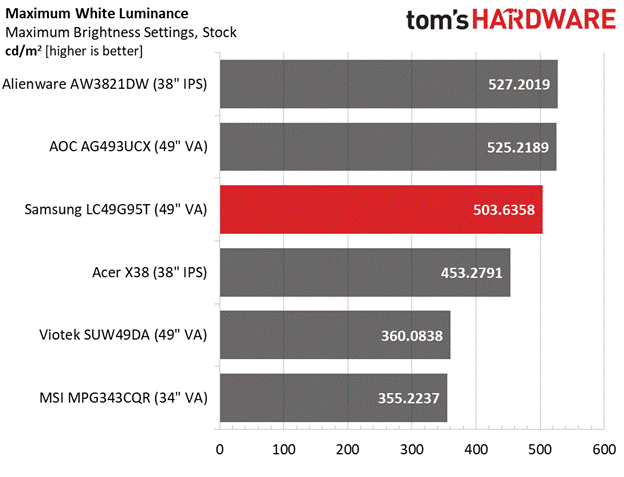
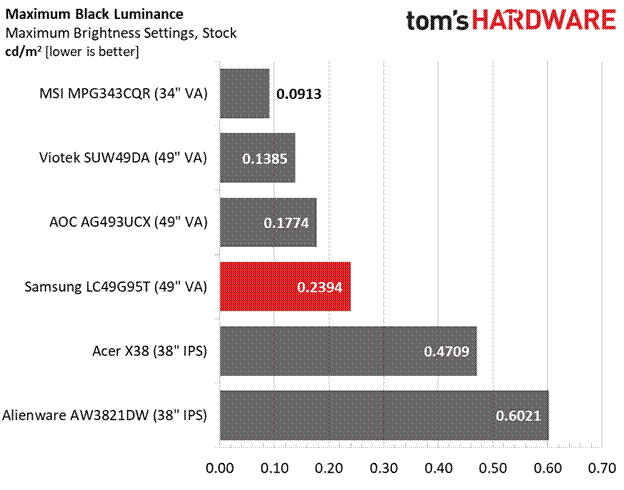
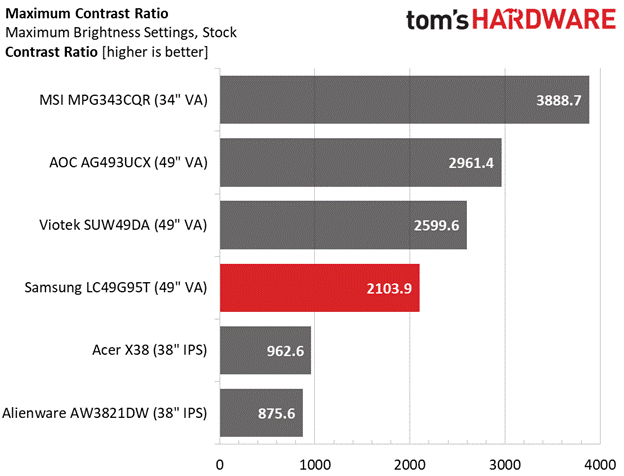
The Odyssey G9 tops 500 nits for SDR signals in both sRGB and Custom picture modes. That’s more than enough brightness for any imaginable environment or task. The drawback of such a high level is that each click of the slider changes output by 3-5 nits. That makes fine adjustments difficult. The minimum level was 73 nits, a little harsh when gaming in the dark.
The four VA panels, including the Samsung, have deep black levels, much deeper than an IPS panel is capable of. The G9 manages to top 2,100:1 contrast, which is very good but not quite up to most VA panels.
Engaging the local dimming improves contrast significantly. We couldn’t measure the black level because the backlight is completely off when an all-black field pattern is displayed. But in practice, it works very well and does not clip shadow detail.
After Calibration to 200 nits
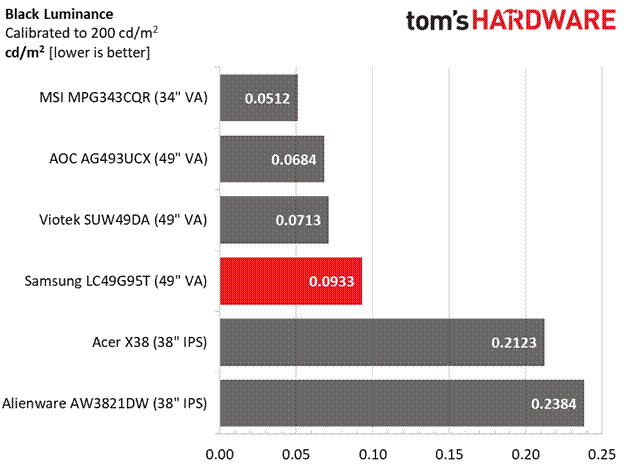
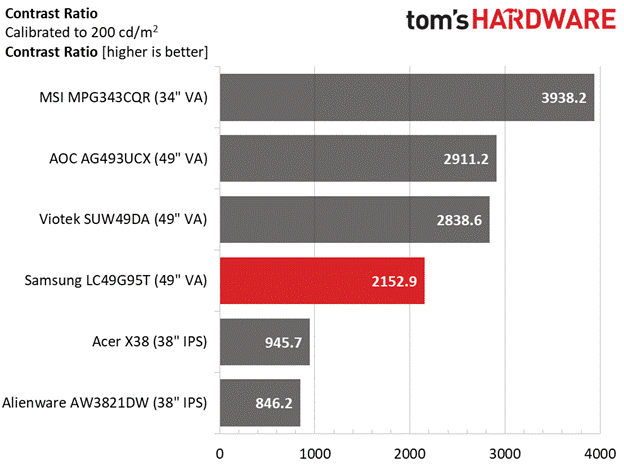
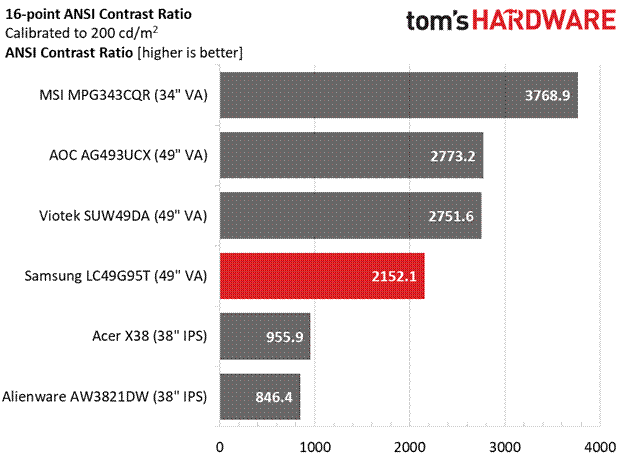
We didn’t calibrate the G9 because it didn’t require it, but we did set it to 200 nits brightness. At that setting, it still has slightly higher black levels than the other screens in our comparison group. This difference becomes moot when local dimming is on. Then, our review focus is superior to the other monitors here.
ANSI contrast stays stable at 2,152.1:1, identical to the static number. Our sample had excellent screen uniformity, which helps this result. The G9 is expensive but does not cut corners in quality control. It is a premium monitor built well from high-end components.
Get Tom's Hardware's best news and in-depth reviews, straight to your inbox.
Current page: Brightness & Contrast
Prev Page Features and Specifications Next Page Grayscale, Gamma & Color
Christian Eberle is a Contributing Editor for Tom's Hardware US. He's a veteran reviewer of A/V equipment, specializing in monitors. Christian began his obsession with tech when he built his first PC in 1991, a 286 running DOS 3.0 at a blazing 12MHz. In 2006, he undertook training from the Imaging Science Foundation in video calibration and testing and thus started a passion for precise imaging that persists to this day. He is also a professional musician with a degree from the New England Conservatory as a classical bassoonist which he used to good effect as a performer with the West Point Army Band from 1987 to 2013. He enjoys watching movies and listening to high-end audio in his custom-built home theater and can be seen riding trails near his home on a race-ready ICE VTX recumbent trike. Christian enjoys the endless summer in Florida where he lives with his wife and Chihuahua and plays with orchestras around the state.
-
Murissokah I was hoping this would be about the supposed 2021 mini-led refresh for the G9, since the original model covered here is a year old by now. It could fix my main gripe with the G9 which is the awfully subpar 10-zone local dimming.Reply
yflpMod7huQ:134View: https://www.youtube.com/watch?v=yflpMod7huQ&t=134s
Any news on the 2021 model would be appreciated. -
Rocastroca I just love mine. It is really a great experience, it sets PC gaming apart. Regardless of the screen size and format, fast, great color, acceptable contrast. Mini LED local dimming would be great IF they are fast enough for gaming.Reply -
Murissokah ReplyRocastroca said:I just love mine. It is really a great experience, it sets PC gaming apart. Regardless of the screen size and format, fast, great color, acceptable contrast. Mini LED local dimming would be great IF they are fast enough for gaming.
Shouldn't affect the panel frequency since it's just a backlight change. Besides, it should be faster than the current dimming tech. There's a supposed leak on the updated version that pretty much keeps all the other specs, but flaunts a VESA DisplayHDR 2000 certification (doesn't even exist yet). Same resolution, response times and support for G-Sync and AMD FreeSync Pro, so no changes there. -
archv I had the previous version of this monitor (the 49" Samsung CRG9). I'd add one "Con" to the list for the G9, which is that the aspect ratio does NOT play well with some games. If stick to the big AAA titles, you'd probably be fine, but if you like to mess around with some indie games, or more niche games, you'll have trouble. Of course you can force it into some terrible 16:9 resolution and have half the monitor be black bars... but that kinda ruins the point doesn't it? I gave the 49" to my 15 yr old son, and got the Samsung G7 32" 16:9 works with everything :) Oddly, I don't miss widescreen AT ALL.Reply -
usiname Reply
This is 2x 27inch 16:9 monitors width, how is that out of the eye vision field?littlechipsbigchips said:49 inch ultra wide? thats out of the eye visual field ... -
littlechipsbigchips Replyusiname said:This is 2x 27inch 16:9 monitors width, how is that out of the eye vision field?
2x27 Monitors are also out of eye vision field. you wont see the edges of the game and the center at the same time -
g-unit1111 I've seen this thing in person and it's a behemoth. I would love to get one, but a bit out of my price range. I think it would be awesome for Flight Simulator!Reply -
littlechipsbigchips Replyg-unit1111 said:I've seen this thing in person and it's a behemoth. I would love to get one, but a bit out of my price range. I think it would be awesome for Flight Simulator!
I prefer VR for flight sims ... Actually VR is perfect for it -
g-unit1111 Replylittlechipsbigchips said:I prefer VR for flight sims ... Actually VR is perfect for it
I have thought about buying a VR headset at one point, that is definitely something on my list.